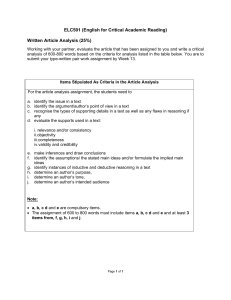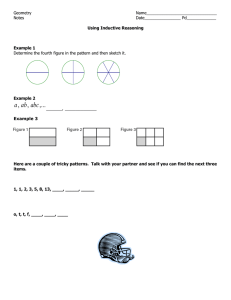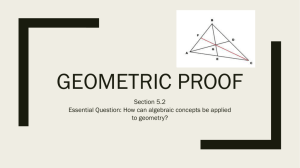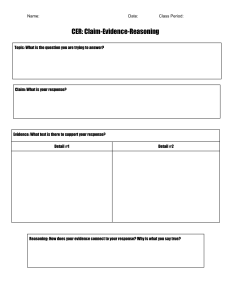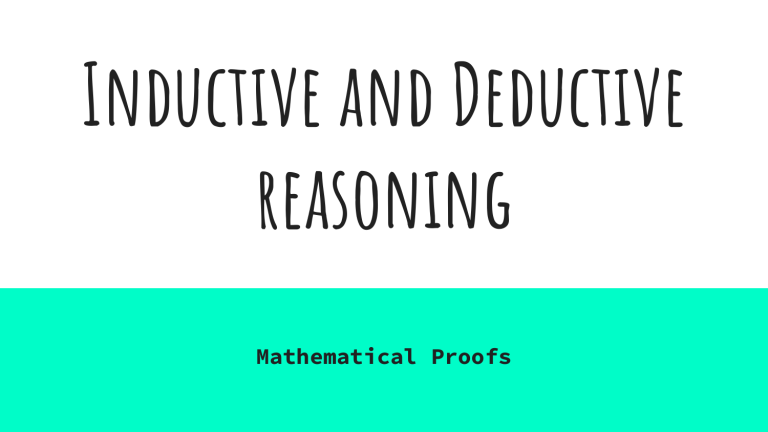
Inductive and Deductive reasoning Mathematical Proofs Why Proofs? Mathematicians need proofs to determine with absolute certainty what is possible. Also, if we don't insist on proofs, mistakes can creep in that aren't easily spotted otherwise. Euclid stated that the sum of the internal angles of all triangles is 180 degrees — he thought this was so obvious, we should just accept it. Mathematicians were struggling with this proof for hundreds of years. During the 19th century it even became a bit of an obsession, but everyone failed to prove that the angles in a triangle always sum to 180 degrees. The reason is that it isn't always true. It only works if you draw your triangle on a flat plane. If you draw it on a sphere, say an orange, the interior angles add up to more than 180 degrees. Inductive Reasoning Inductive Reasoning is the process of drawing a general conclusion by observing a pattern. This conclusion is called a conjecture - basically a pretty decent guess. Validity and Counterexamples of Conjectures Make a conjecture How could you validate your conjecture? How could a conjecture Be shown to be invalid? Make a conjecture How could you validate your conjecture? Conjecture: An 8.5 x 11 piece of paper can be cut so that a person will fit through it. Could you validate this conjecture? Tutorial Deductive Reasoning Deductive reasoning is how we can prove conjectures; by connecting ideas that we know to be true. Ex:All numbers ending in 0 or 5 are divisible by 5. The number 35 ends with a 5, so it must be divisible by 5. Cacti are plants, and all plants perform photosynthesis. Therefore, cacti perform photosynthesis. Incorrect example:All farmers like burgers. Jethro likes chicken wings. Therefore, Jethro is not a farmer. Use deductive reasoning to reach a conclusion for each statement: A person must be 12 years old or over to have a fishing license. What can be deduced with certainty about each person? a) Sally has a fishing license b) Bill went fishing c) Lora is 15 years old d) George is under 12 years old e) Tim does not fish Use deductive reasoning to reach a conclusion for each statement: All members of the volleyball team are over 6 feet tall. What, if anything, can you deduce with a certainty about each person? a) Sue is on the Volleyball Team b) Tom is over 6ft tall c) Mary is 5′6" tall d) Bert is not on the Volleyball Team When proving conjectures deductively we use general cases in our final proof. This is to demonstrate that the proof applies to all cases. The difference between consecutive perfect squares is always an odd number Statement and Evidence Choose a number, triple the number, add 6, subtract the original number, divide by 2 and subtract 3. The result is the original number. Left side Right side Q.E.D. "Which was to be demonstrated." Terminology Invalid proof: A proof that contains an error in reasoning or that contains invalid assumptions (fallacy) Premise: A statement assumed to be true Circular reasoning: An argument that is incorrect because it makes use of what you’re trying to prove in the first place. Proofs that aren’t valid Conjecture: 4 = 3 Suppose: a+b=c This can be rewritten as: 4a – 3a + 4b – 3b = 4c – 3c If we reorganize: Factor using distributive property: Divide both sides by (a + b – c): Where is the error in deduction? 4a + 4b – 4c = 3a + 3b – 3c 4 (a + b – c) = 3 (a + b – c) 4=3 Reasoning to Solve Problems Thinking logically can help in problem solving. Inductive thinking: Simplifying a problem, looking for patterns, drawing conclusions from observations Deductive thinking: Using facts or assumptions to make an argument, and drawing logical conclusions from the argument Suppose you were lost in the woods and came upon a cabin. In the cabin there was a lantern, candle, wood stove (with wood) and a match. In what order to you light things? Which kind of reasoning did you use? Making game predictions Click here Click here
